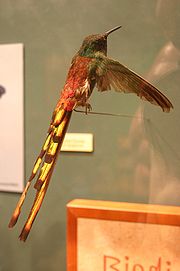New Hummingbird Discovered in Peru
Posted by: Loren Coleman on August 1st, 2009
Isabel Guerra writing from Peru notes that “Cesar Sanchez Morales, a scientist from Louisiana State University (US), identified 290 species during his 40-days stay at Cerros de Amotape National Park, in Tumbes region. During his visit, Sanchez identified for the first time a new species of hummingbird; the colirrojizo (red-tail), that had not been registered before.”
Perhaps the use of the name colirrojizo indicates it is ethnoknown locally. For Peru, there is also a locally seen bird with the Spanish name of mosquerito colirrojizo, which is known in English as the ruddy-tailed flycatcher, and in Latin, Terenotriccus erythrurus.
No photos or further info appears to be available yet on this new “red-tailed hummingbird” of Peru.
It is worthy of mentioning that there is a bird (pictured below) called the red-tailed comet (Sappho sparganura), which is a medium-sized hummingbird found in the central Andes of Bolivia and Argentina.

Martin Johnson Heade
Red-tailed Comet (hummingbird) in the Andes
Gift of Herbert W. Plimpton: The Hollis W. Plimpton (Class of 1915) Memorial Collection
For those that like to plan ahead, Mead Art Museum at Amherst College in Amherst, Massachusetts, has this forthcoming Faculty Lunchtime Talk:
December 4, 2009
12:00 p.m.
free to all
Rick Lopez Assistant Professor of History, will speak on the “Red-tailed Comet (hummingbird) in the Andes” by Martin Johnson Heade in this free, ten-minute gallery talk.
About Loren Coleman
Loren Coleman is one of the world’s leading cryptozoologists, some say “the” leading living cryptozoologist. Certainly, he is acknowledged as the current living American researcher and writer who has most popularized cryptozoology in the late 20th and early 21st centuries.
Starting his fieldwork and investigations in 1960, after traveling and trekking extensively in pursuit of cryptozoological mysteries, Coleman began writing to share his experiences in 1969. An honorary member of Ivan T. Sanderson’s Society for the Investigation of the Unexplained in the 1970s, Coleman has been bestowed with similar honorary memberships of the North Idaho College Cryptozoology Club in 1983, and in subsequent years, that of the British Columbia Scientific Cryptozoology Club, CryptoSafari International, and other international organizations. He was also a Life Member and Benefactor of the International Society of Cryptozoology (now-defunct).
Loren Coleman’s daily blog, as a member of the Cryptomundo Team, served as an ongoing avenue of communication for the ever-growing body of cryptozoo news from 2005 through 2013. He returned as an infrequent contributor beginning Halloween week of 2015.
Coleman is the founder in 2003, and current director of the International Cryptozoology Museum in Portland, Maine.











Here’s another new one: Laos’ bare-faced bulbul, Pycnonotus hualon, is the first Asian bulbul to be found in a century.
The discovery of the humingbird mentioned above puts an exclamation mark on what I called on my blog a very odd comment by Peter Clyne of the Wildlife Conservation Society. He said, “To find a new bird species is very rare these days. It’s not like we’re finding new species of birds every year.”
Actually, Peter, we are adding new species every year: granted, it’s just a few, but we are.
Yes, Matt, that new bulbul was noted here two days ago.
Obviously, Mr. Clyne is not reading the right blogs. 🙂
cool. thanx for the post Loren